Session 7: Cellular Adaptations
1/73
There's no tags or description
Looks like no tags are added yet.
Name | Mastery | Learn | Test | Matching | Spaced |
|---|
No study sessions yet.
74 Terms
The size of cell populations in adults depends on what factors?
- Rate of cell proliferation
- Rate of cell differentiation
- Rate of cell death by apoptosis
Increased numbers of cells are seen with increased ___ or decreased ____ ____
Increased numbers of cells are seen with increased proliferation or decreased cell death (by apoptosis)
Types of Cell Signalling
Autocrine, paracrine, endocrine
Autocrine
Referring to a secreted molecule that acts on the cell that secreted it. Cells respond to signalling molecules that they themselves produce.
Intracrine signalling is a type of autocrine signalling where the cell synthesises a factor which has an effect by binding to intracellular receptors within that cell.
Paracrine
Referring to a secreted molecule that acts on a neighboring cell. The responding cells are close to the secreting cells and are often of a different type.
Endocrine
Hormones synthesised by cells in an endocrine organ, they are transported in the bloodstream to target cells (distant from the site of synthesis) to effect physiological activity.
Compare apoptosis to necrosis

What are growth factors
- Proteins that stimulate cell division
- Local mediators that are involved in cell proliferation
- Polypeptides that act on cell surface - 'local hormones'
- Stimulate cell proliferation (mainly) but may also affect cell locomotion, contractility, differentiation and angiogenesis
What are growth factors coded for by?
Proto-oncogenes
Epidermal Growth Factor (EGF)
- Mitogenic for epithelial cells, hepatocytes & fibroblasts
- Produced by keratinocytes, macrophages & inflammatory cells
- Binds to epidermal growth factor receptor (EGFR)
Vascular Endothelial Growth Factor (VEGF)
- Inducer of blood vessel development (vasculogenesis)
- Role in growth of new blood vessels (angiogenesis) in tumors, chronic inflammation & wound healing
Platelet-derived Growth Factor (PDGF)
- Stored in platelet alpha granules, released on activation of platelets
- Also produced by macrophages, endothelial cells, smooth muscle cells & tumour cells
- Causes migration and proliferation of fibroblasts, smooth muscle cells and monocytes
Granulocyte Colony Stimulating Factor (GCSF)
- Stimulates the bone marrow to produce granulocytes and release them into the blood (particularly neutrophils)
- Treatment to stimulate poorly functioning bone marrow e.g., during chemotherapy & renal failure
Name all four phases of the cell cycle in order
1) G1
2) S
3) G2
4) M
G1 phase
Preparation for DNA synthesis.
Cellular contents, excluding the chromosomes are duplicated.
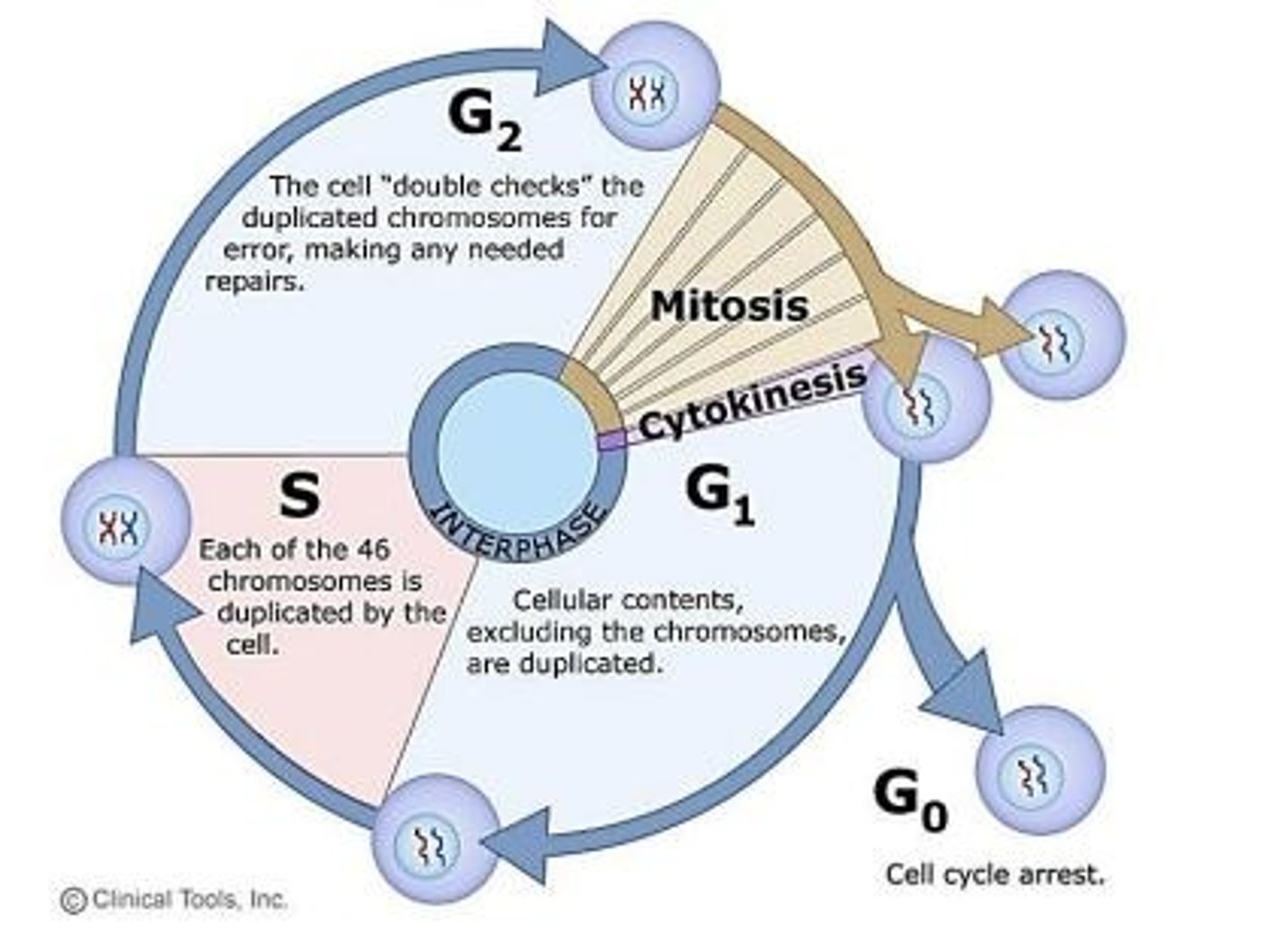
S phase
Each of the 46 chromosomes is duplicated by the cell.
DNA synthesis.

G2 phase
Preparation for mitosis.
The cell "double checks" the duplicated chromosomes for any errors, making any needed repairs where necessary.
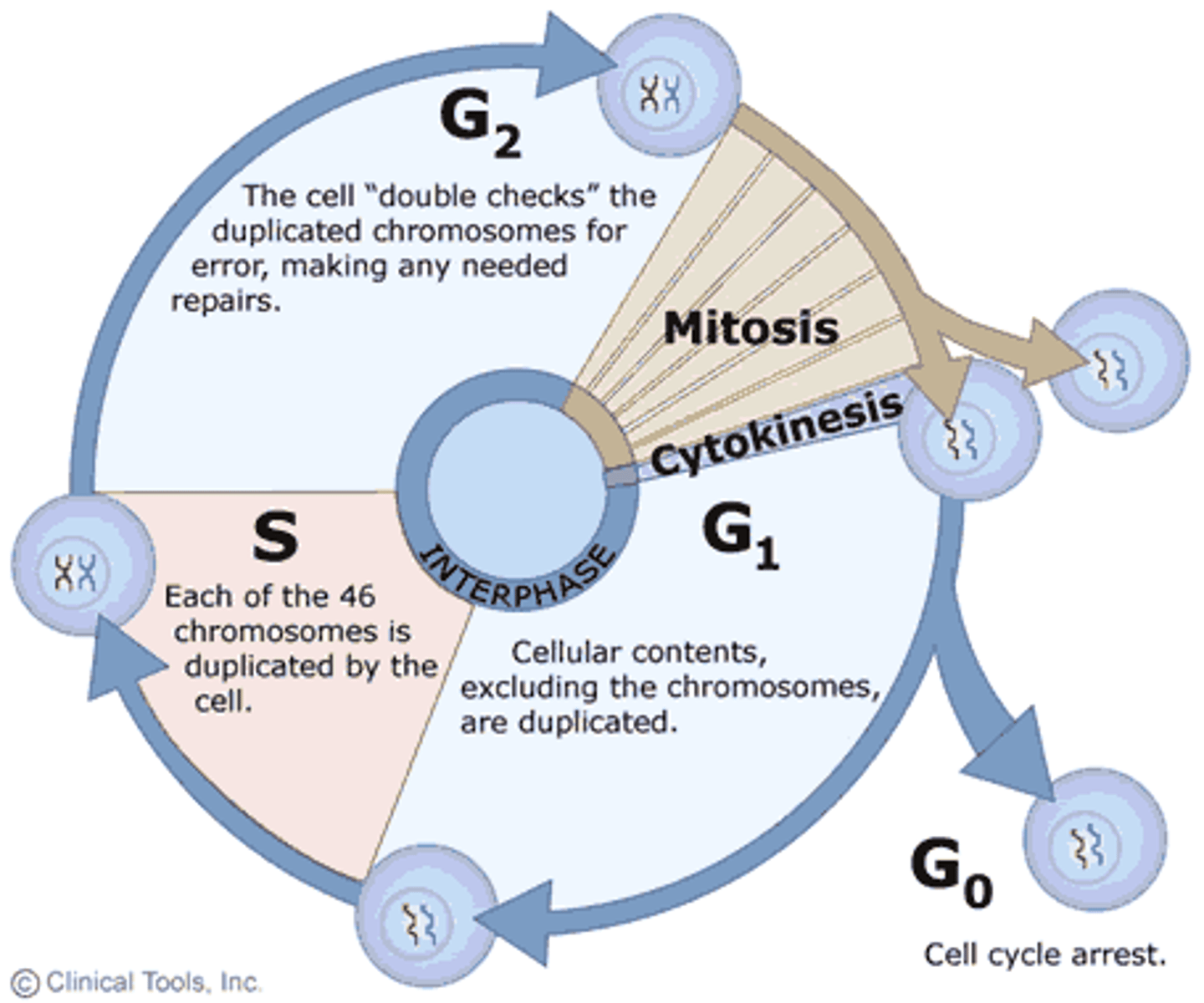
Under the light microscope, only the ___ phase of the cell cycle is distinctive
Under the light microscope, only the M phase of the cell cycle is distinctive
Why are checkpoints important in the cell cycle?
Checkpoints are important because they can ensure the cell is ready to enter the next phase, verify the necessary stage processes and repair DNA damage.
Checkpoints ensure that one phase does not commence until the previous phase is complete. Failure of a phase to complete satisfactorily results in cell cycle arrest or apoptosis.
Considering the cell cycle process - how can we increase growth of cells?
- Shortening the cell cycle.
- Converting quiescent cells to proliferating cells by making them enter the cell cycle.
Majority of cells that pass the ___ point at the end of G1 phase of the cell cycle will complete the full cell cycle (this is a point of no return).
Majority of cells that pass the restriction (R) point at the end of G1 phase of the cell cycle will complete the full cell cycle (this is a point of no return).
R point is the most commonly altered checkpoint of the cell cycle in cancer cells.
Checkpoint activation delays cell cycle and triggers DNA repair mechanisms or apoptosis via p53.
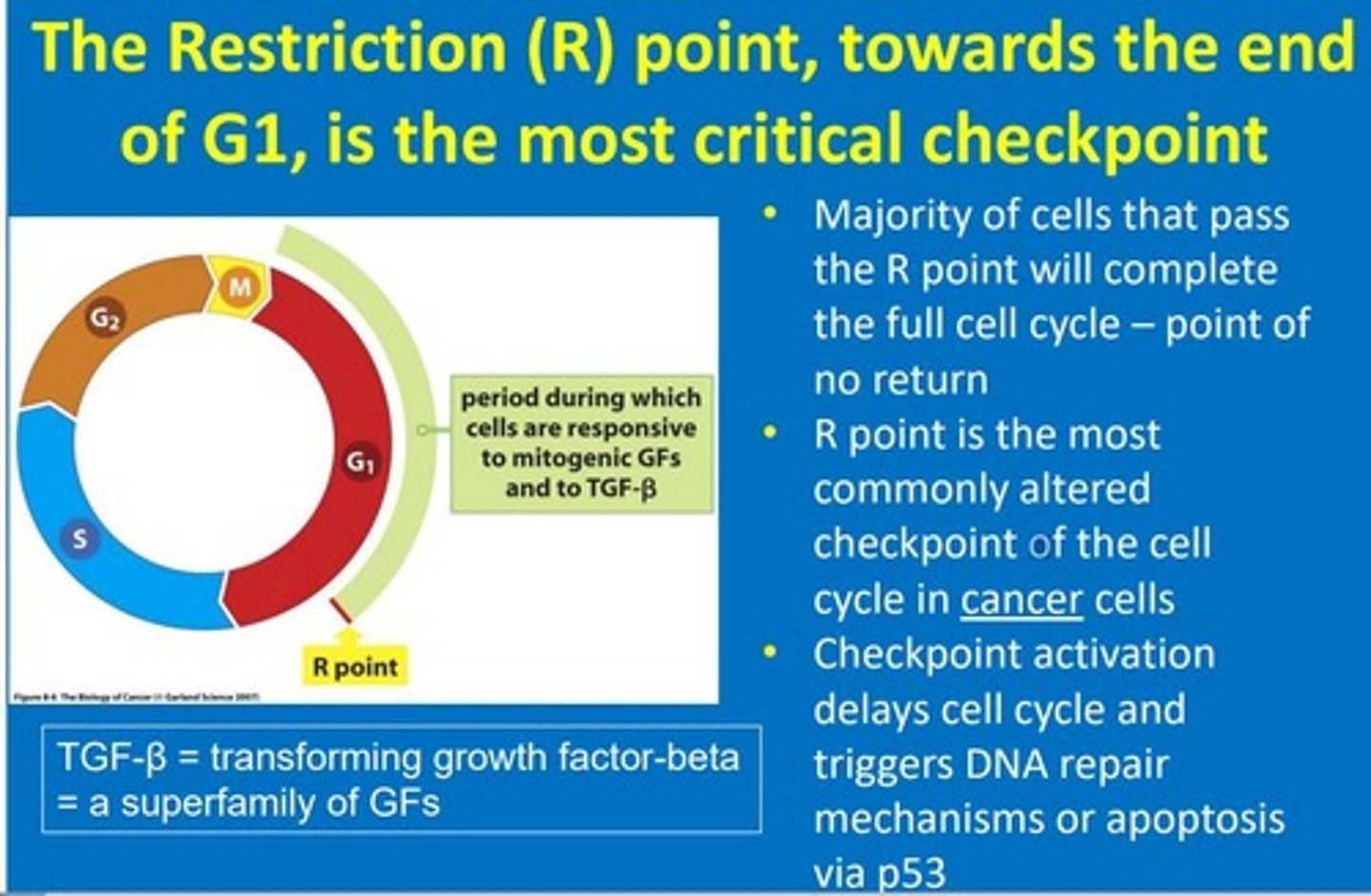
Progression through the cell cycle, and particularly the G1/S transition is tightly regulated by proteins called ___ and associated with enzymes called ___ ___ ___.
Progression through the cell cycle, and particularly the G1/S transition is tightly regulated by proteins called cyclins and associated with enzymes called cyclin-dependent kinases (CDKs).
Activated CDK enzymes drive the cell cycle by phosphorylating proteins that are critical for cell cycle transitions. Many growth factors stimulate the production of cyclins.
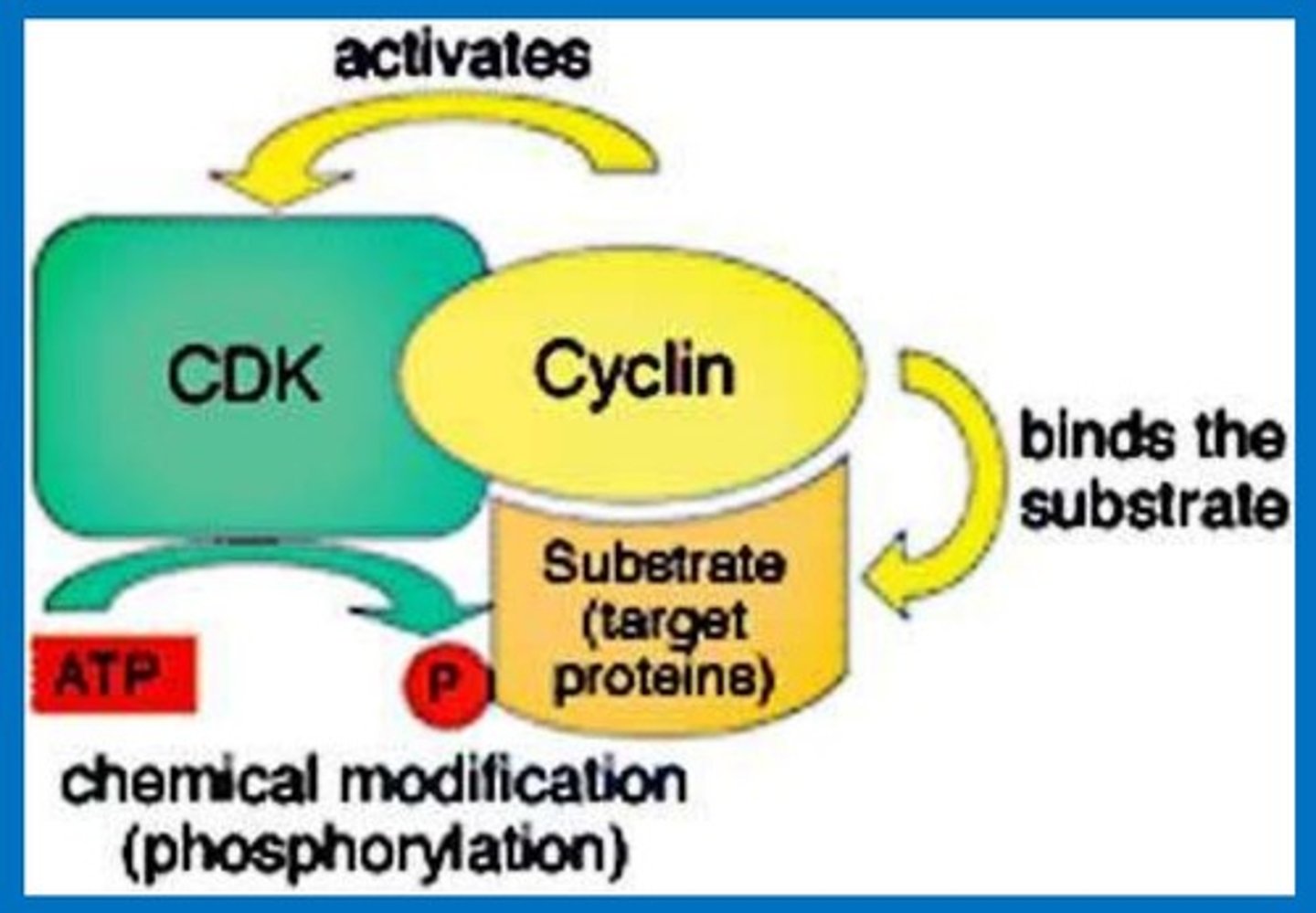
Cell populations can be classified according to their ability to enter the cell cycle. What are the three classifications which help to define this?
1) Labile
2) Stable
3) Permanent
Labile tissues
Continuously dividing tissues throughout life
Example = bone marrow and epithelium
Stable tissues
Cells that are quiescent (G0), but can reenter the cell cycle to regenerate as necessary (when presented with a growth stimulus).
Cells that can multiply in a regenerative burst but are generally quiescent.
Example = liver hepatocytes, bone osteoclasts, fibroblasts, smooth muscle cells and vascular endothelial cells
Permanent tissues
Cells that cannot proliferate
G0 = terminal differentiated cells
Example = cardiac muscle, skeletal muscle, neural tissue
Stem cell
Unspecialized cell that can give rise to one or more types of specialized cells

What is the regenerative capacity of...
Bone
Very good
What is the regenerative capacity of...
Tendons
Poor
Tendons heal very slowly as they have few cells/blood vessels. Therefore, secondary rupture at a site of previous injury is not uncommon.
What is the regenerative capacity of...
Articular cartilage
Poor
What is the regenerative capacity of...
Adipocytes
Nil
New fat cells are formed by undifferentiated but committed cells that lie among the adipocytes.
What is the regenerative capacity of...
Epithelia
Very good
Exceptions: lens of the eye and renal podocytes
What is the regenerative capacity of...
Liver
Very good
Transplanted livers adjust their size to the size of the recipient. More than 70% of a rat liver can be removed, and it will regrow in 7 days.
What is the regenerative capacity of...
Mesothelia
Good
What is the regenerative capacity of...
Melanocytes
Tend to regenerate too much or too little
What is the regenerative capacity of...
Smooth muscle
Very good
What is the regenerative capacity of...
Peripheral nerves
Regenerate in a predictable way
Sprouting axons grow at 1-3mm/day.
If the gap the regenerating axons have to cross is too wide, they form a disordered tangle which can result in a painful amputation neuroma.
What is the regenerative capacity of...
Central nervous system
Lost neurones cannot be replaced (they cease to multiply before birth).
Severed CNS axons do not grow back effectively.
Give some examples of factors which induce cell regeneration
1) Growth factors in microenvironment
2) Cell-to-cell communication
3) Electric currents and nervous stimuli also appear to play a role in the reconstitution of limbs in amphibians
What are the five main important types of cellular adaptation?
Regeneration = multiply to replace losses
Hyperplasia = increase in number above normal
Hypertrophy = increase in size
Atrophy = become smaller
Metaplasia = replaced by different type of cell
Dysplasia = cells change morphology
Regeneration
Replacement of cell losses by identical cells to maintain tissue or organ size
- Regenerative capacity of tissues vary
- Only stem cells can regenerate indefinitely
Hayflick number
Amount of times a line of cells can divide before telomere loss prevents further division.
Hayflick number varies dependent on the species (maximum lifespan of the species).
Reconstitution
Replacement of a lost part of the body. Requires a coordinated regeneration of several types of tissues.
Mammals have very minimal ability to reconstitute body parts.
Small blood vessels are able to reconstitute in wound healing.
Hyperplasia
Increase in tissue or organ size due to increased cell numbers
- Can only occur in stable or labile cell populations
- Hyperplasia remains under physiological control and is reversible
Hyperplasia - physiological
1) Hormonal (increase in breast gland for lactation)
2) Bone marrow produces erythrocytes in response to hypoxia
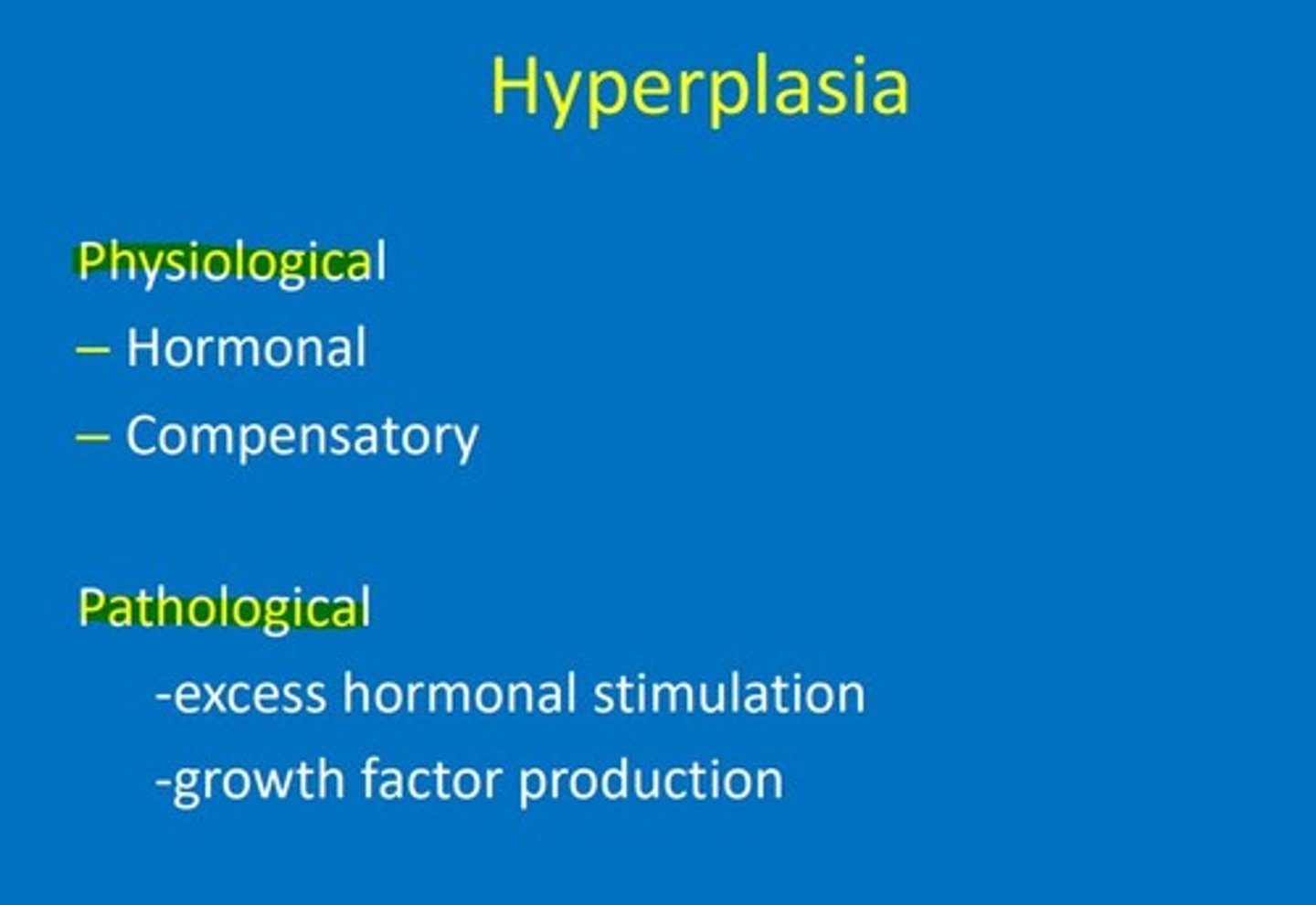
Hyperplasia - pathological
Thyroid goitre in iodine deficiency
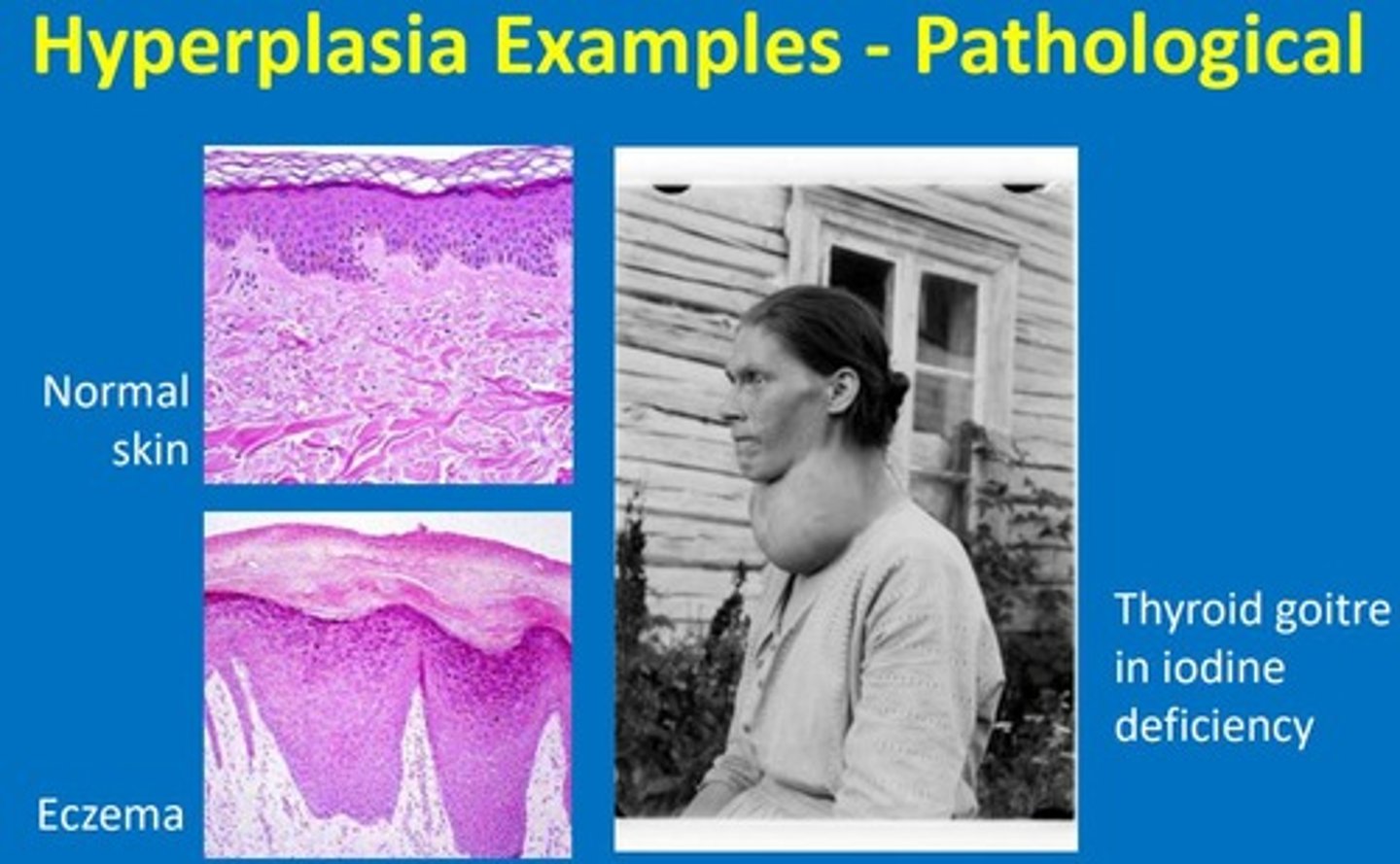
Pathological hyperplasia usually occurs secondary to ___ ___ ___ or ___ ___ ___
Pathological hyperplasia usually occurs secondary to excess hormonal stimulation or growth factor production
Hypertrophy
Increase in tissue or organ size due to increase in cell size without increase in cell number
- Cells become bigger because they contain more structual components (not because of swelling)
- Seen especially in permanent tissues
Why does hypertrophy mainly occur in permanent tissues?
Hypertrophy (increase in tissue or organ size due to increase in cell size without increase in cell number) is seen especially in permanent tissues because these tissues have little replicative capacity and so increase in organ size MUST occur via hypertrophy
Hypertrophy - physiological
- Skeletal muscle when lifting weights
- Uterus during pregnancy (hypertrophy & hyperplasia)

Hypertrophy - pathological
- Ventricular cardiac hypertrophy due to hypertension
- Bladder smooth muscle hypertrophy with obstruction due to enlarged prostate gland (hypertrophy & hyperplasia)
Atrophy
Shrinkage of a tissue or organ due to an acquired decrease in size and/or number of cells
Atrophy - Physiological
1) Ageing = thymus gland atrophy as age
2) Ovarian atrophy = post-menopausal women
3) Decrease in size of uterus = after parturition (childbirth)
Atrophy - Pathological
1) Disuse = if really prolongs may not be reversible
2) Denervation = irreversible because the nerve is gone
3) Ischemia/Inadequate nutrition = survival mechanism is for cells to shrink to conserve energy, if enough time goes by damage may be irreversible
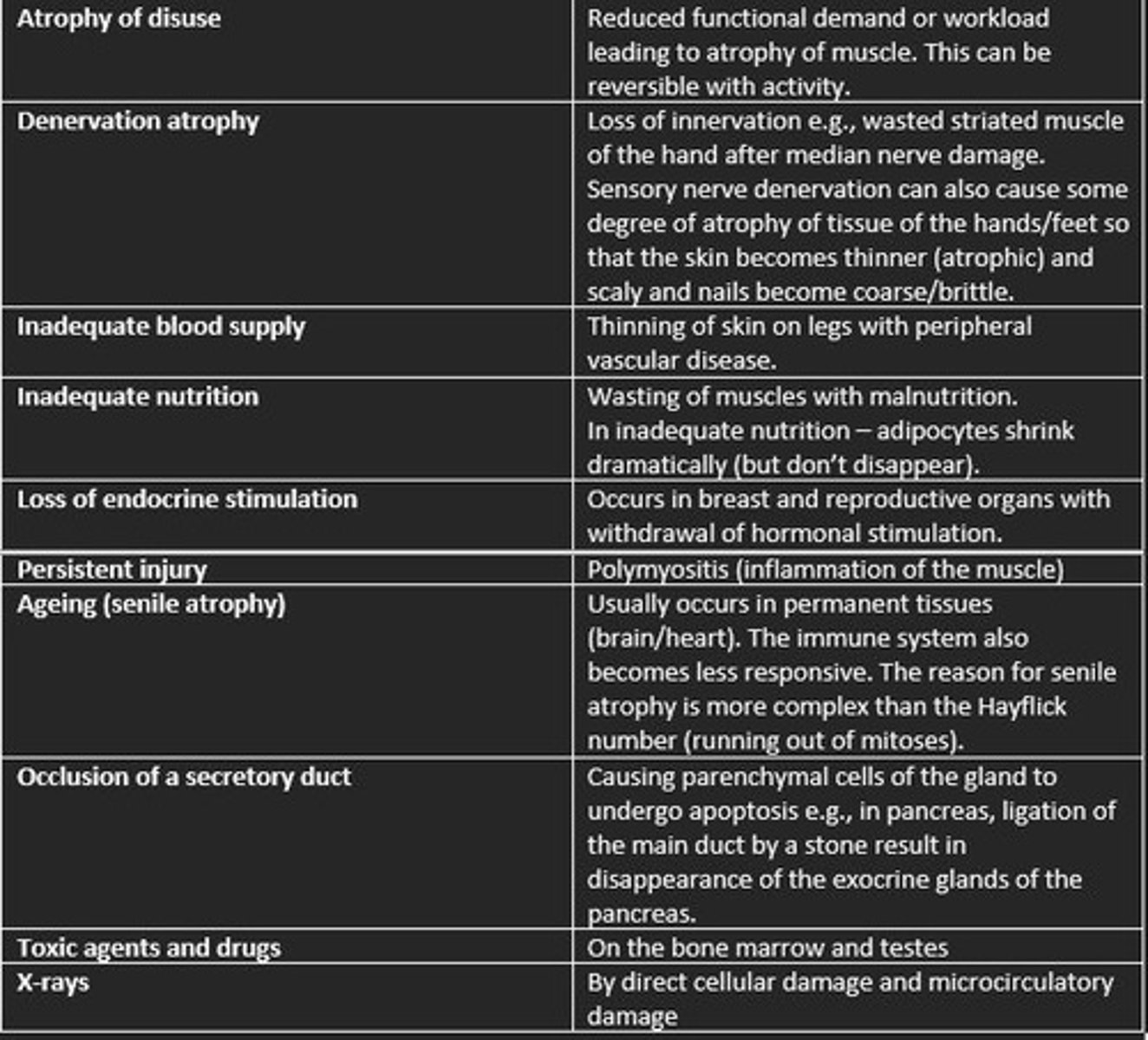
Mechanism of atrophy
1) Decreased protein synthesis
2) Increased protein degradation (ubiquitin proteasome path)
3) Increased autophagy (residual bodies; autophagosomes with lipofuscin)
Metaplasia
Reversible replacement of one adult differentiated cell type to another
- Metaplasia involves expression of new genetic program
- Adaptive substitution of cells that are sensitive to stress (e.g., columnar epithelium) by cell types better able to withstand the adverse environment (e.g., squamous epithelium)
Metaplastic epithelium is ___ differentiated
Metaplastic epithelium is fully differentiated
Dysplastic epithelium has ___ and ___ differentiation
Dysplastic epithelium has abnormal and disorganised differentiation
Sometimes metaplasia can be useful and adaptive.
Give an example of this.
If the bone marrow is destroyed by disease - splenic tissue undergoes metaplasia to bone marrow (myeloid metaplasia).
Sometimes metaplasia is of no apparent use and may be detrimental.
Give an example of this.
Transformation of bronchial pseudostratified ciliated columnar epithelium to stratified squamous epithelium occurs due to the effect of cigarette smoking.
This means that the squamous epithelium doesn't produce cleansing mucus and lacks cilia to move it along. This makes the smoker more vulnerable to respiratory infections.
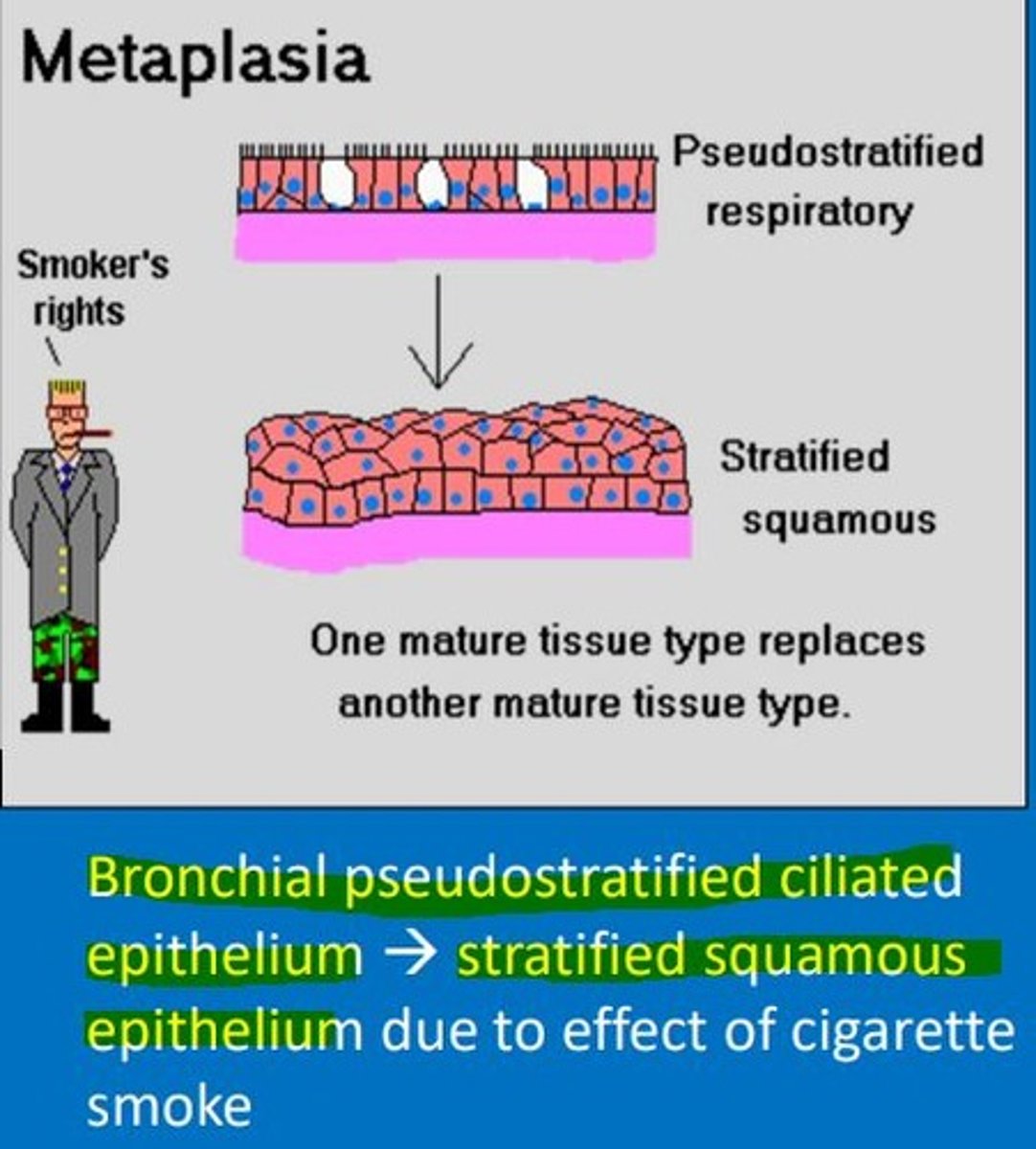
Metaplasia can sometimes be a prelude to dysplasia and cancer.
Give an example of this.
Severe types of epithelial metaplasia predispose to malignant epithelial cancers e.g., Barret's oesophagus and intestinal metaplasia of the stomach (which occurs in chronic H. pylori infection).
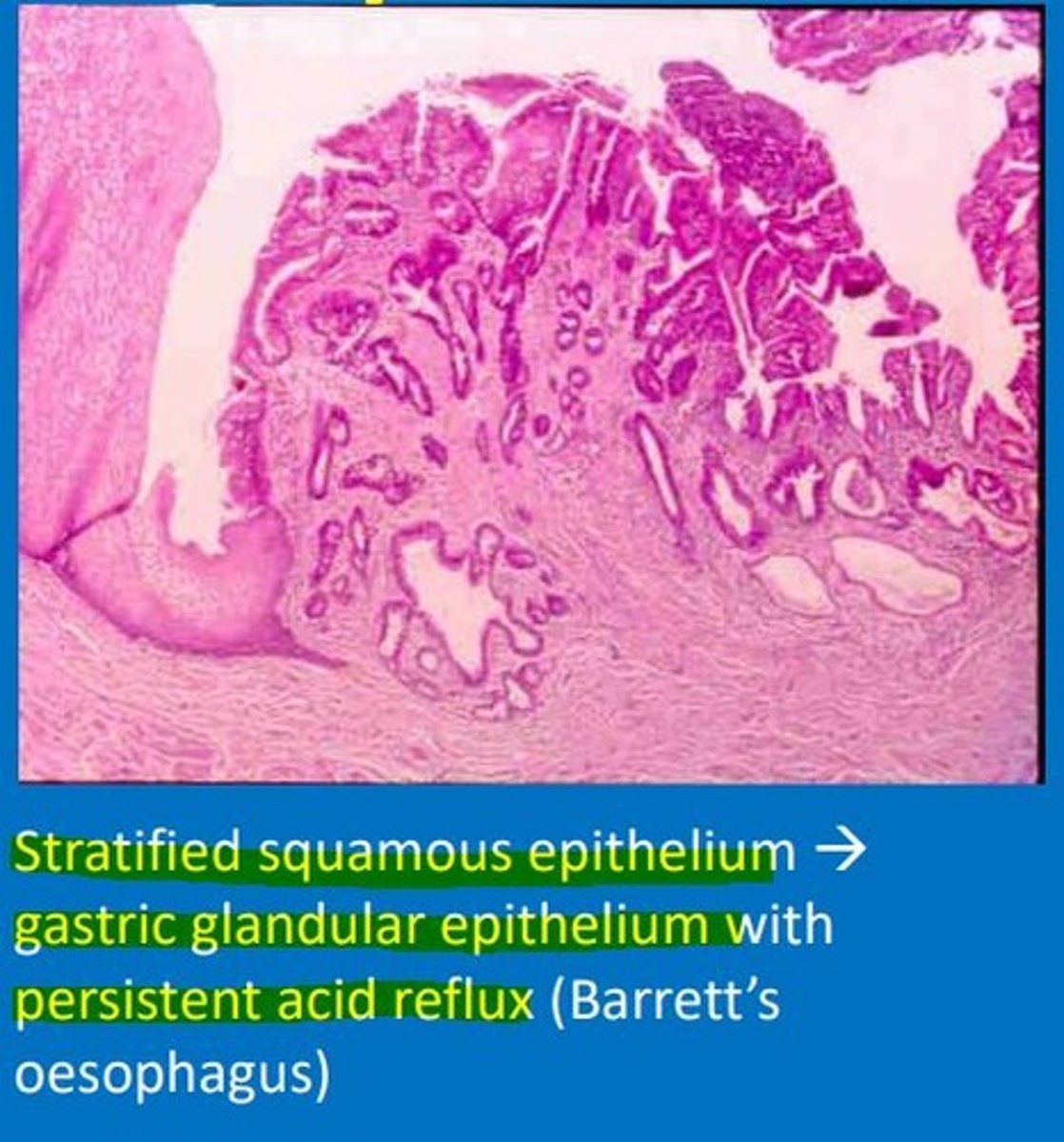
Aplasia
Complete failure of a specific tissue or ogan to develop.
- It is an embryonic developmental disorder e.g., thymic aplasia which results in infections and autoimmune problems
- Aplasia can also be used to describe an organ whose cells have CEASED to proliferate e.g., aplasia of the bone marrow in aplastic anemia.
Involution
The normal programmed shrinkage of an organ e.g., uterus after childbirth, thymus in childhood, temporary fetal organs such as pro- and meonephros.
Hypoplasia
Congenital underdevelopment or incomplete development of a tissue or organ. There are inadequate numbers of cells within the tissue.
- Embryonic developmental disorder
Atresia
Means 'no orifice'. The congenital imperforation of an opening e.g., atresia of the anus or esophagus.
Dysplasia
Abnormal maturation of cells within a tissue.
The cells are abnormal in size, shape, uniformity, arrangement and structure.
- Potentially reversible
- It is often a pre-cancerous condition
Dysplasia can have two different meanings in pathology.
What are they and how do they differ?
1) Abnormal cellular development with abnormal cell cycling and accumulating genetic abnormalities leading to cancer.
2) Abnormal development and maturation leading to malformation of an organ e.g., renal dysplasia and fibrous dysplasia of bone.
Atrophy may be caused by...
Answer true or false
a) Decreased workload
b) Loss of innervation
c) Diminished blood supply
d) Acute inflammation
e) Endocrine stimulation
Atrophy may be caused by...
Answer true or false
a) Decreased workload = true
b) Loss of innervation = true
c) Diminished blood supply = true
d) Acute inflammation = false
e) Endocrine stimulation = false
Examples of metaplasia include...
Answer true or false
a) Squamous metaplasia of ductal epithelium of prostate
b) Squamous metaplasia of endocervical epithelium
c) Intestinal metaplasia of gastric mucosa
d) Columnar metaplasia of rectal mucosa
e) Columnar metaplasia of bronchus
a) Squamous metaplasia of ductal epithelium of prostate = true
b) Squamous metaplasia of endocervical epithelium = true
c) Intestinal metaplasia of gastric mucosa = true
d) Columnar metaplasia of rectal mucosa = false
e) Columnar metaplasia of bronchus = false
Hypertrophy of smooth muscle occurs in the following situations...
Answer true or false
a) The breast during pregnancy
b) The muscles of a body builder
c) The left ventricle in systemic hypertension
d) The bladder in some cases of prostatic enlargement
e) The colon in diverticular disease
a) The breast during pregnancy = false
b) The muscles of a body builder = false
c) The left ventricle in systemic hypertension = false
d) The bladder in some cases of prostatic enlargement = true
e) The colon in diverticular disease = true
Hyperplasia of the thyroid gland...
Answer true or false
a) Occurs in Cushing's syndrome
b) Occurs in Grave's disease
c) Is caused by increased levels of prolactin
d) May occur in iodine deficiency
e) Leads to myxoedema
a) Occurs in Cushing's syndrome = false
b) Occurs in Grave's disease = true
c) Is caused by increased levels of prolactin = false
d) May occur in iodine deficiency = true
e) Leads to myxoedema = false
In the cell cycle...
Answer true or false
a) DNA is synthesised during G1
b) Permanent cells may enter G0 and stay there
c) Cyclins co-ordinate the passage of cells through the cell cycle
d) Labile tissues are continuously proliferating
e) M phase is the period during which mitosis occurs
a) DNA is synthesised during G1 = false
b) Permanent cells may enter G0 and stay there = true
c) Cyclins co-ordinate the passage of cells through the cell cycle = true
d) Labile tissues are continuously proliferating = true
e) M phase is the period during which mitosis occurs = true
Describe the three types of cell populations & give examples of each
1) Labile cell populations
Stem cells divide persistently to replenish losses
E.g., skin epidermis, gut epithelium, bone marrow
2) Stable cell populations
Stem cells are normally quiescent or proliferate very slowly, but proliferate when REQUIRED
E.g., liver hepatocytes, bone osteoblasts
3) Permanent cell populations
Stem cells are present, but cannot mount an effective proliferative response to significant cell loss
E.g., cardiac and skeletal muscle, brain neurons
List the 5 main types of cellular adaptation to insults in the body
1) Regeneration
2) Hyperplasia
3) Hypertrophy
4) Atrophy
5) Metaplasia